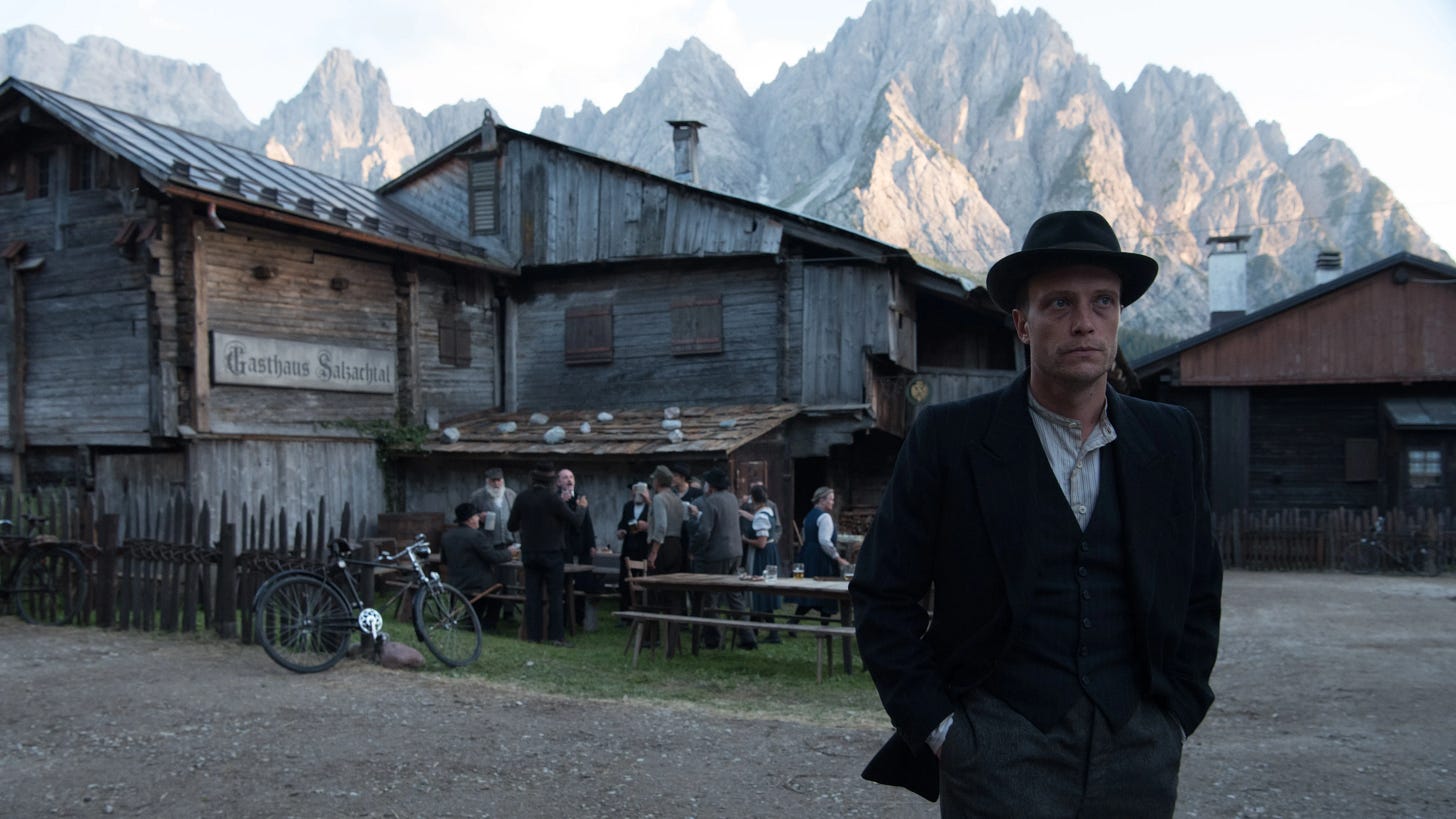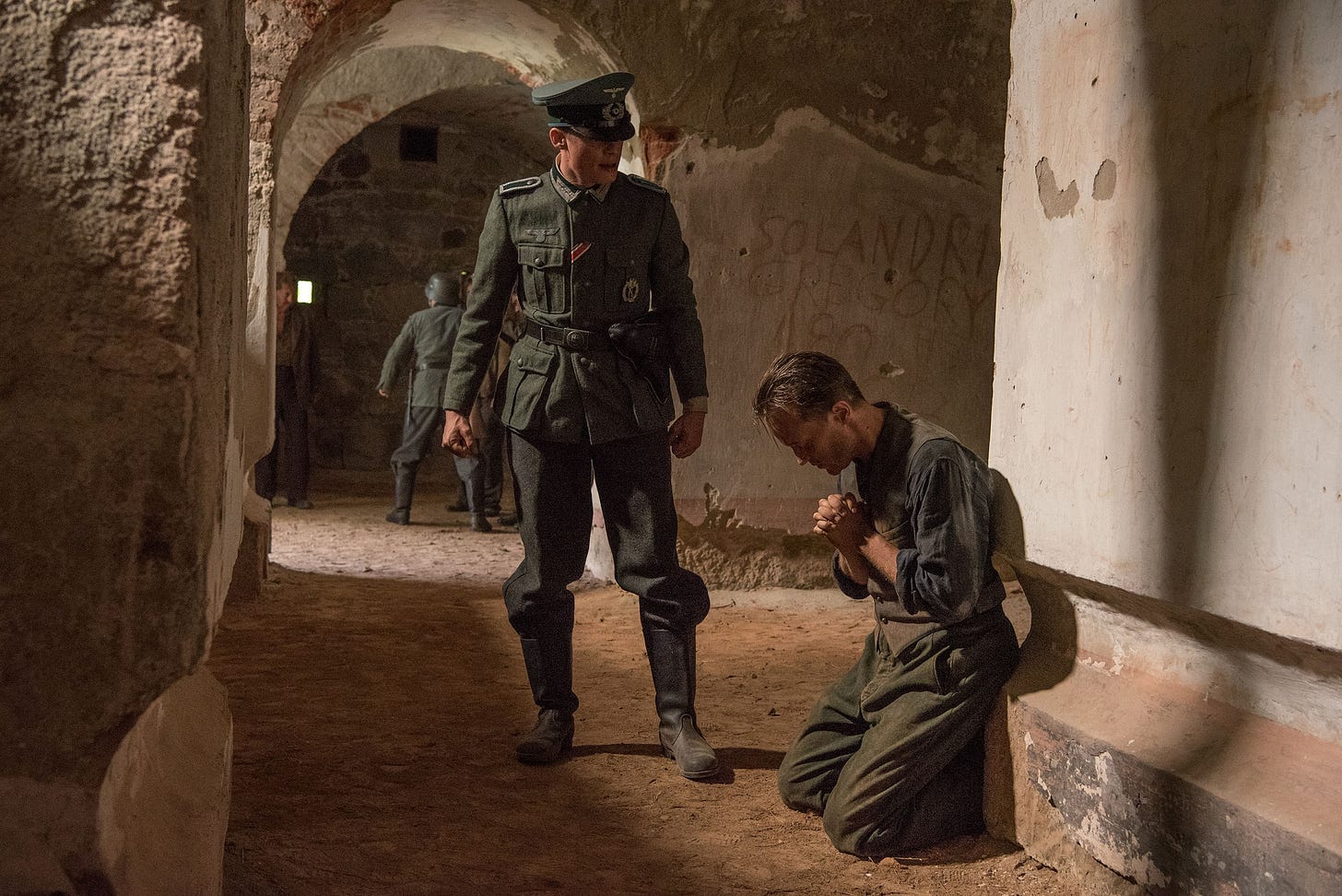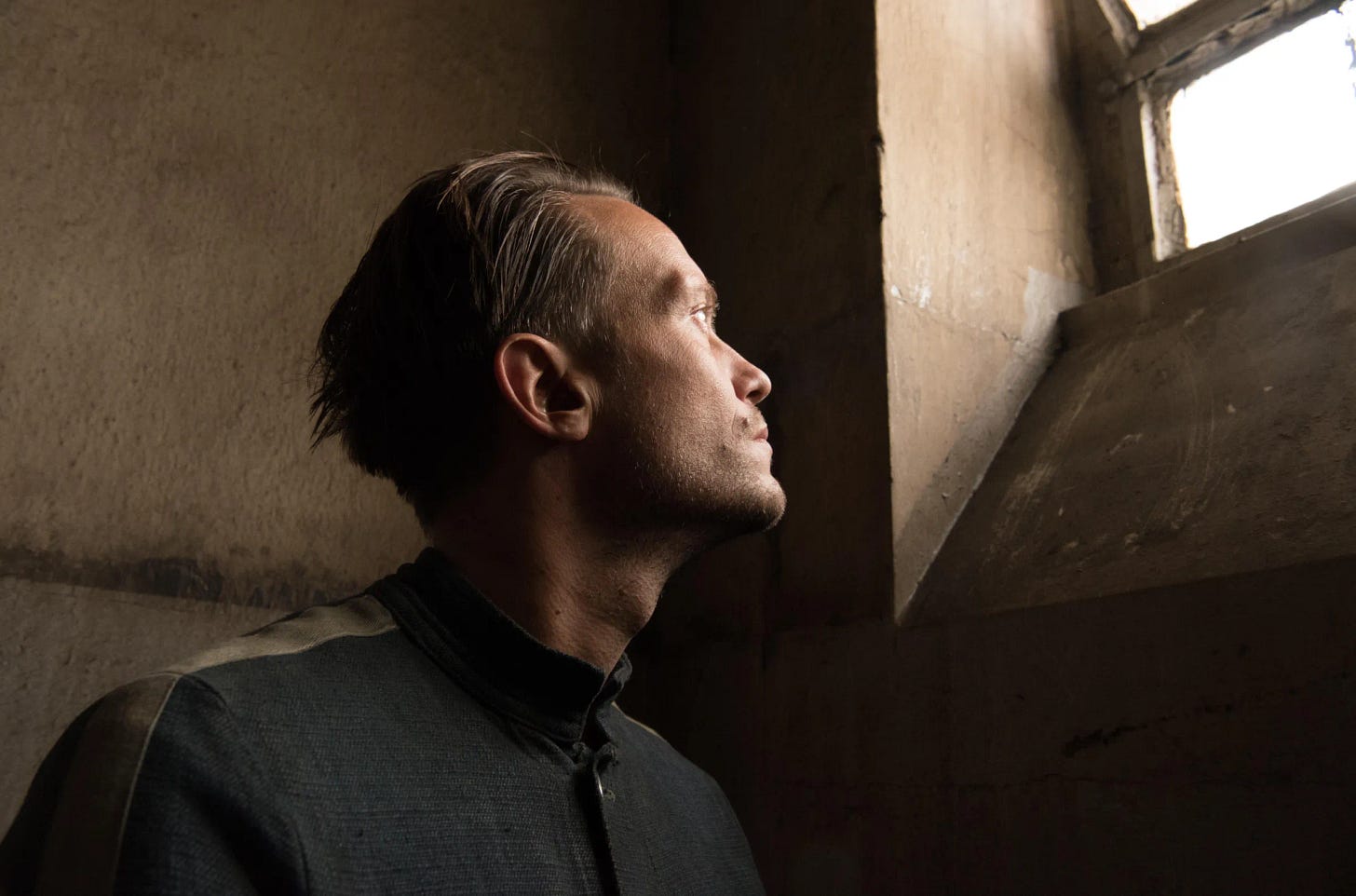As our culture continues its slow, aching bend toward acquiescence and accommodation of authoritarian power, ideas, principles, and propaganda, I am writing a series about the lessons of representation of authoritarianism and resistance in cinema. Thanks for reading and please share if you are so inclined.
Previously:
#1: SALÓ, OR THE 120 DAYS OF SODOM
#2: TONY MANERO
#3: THE CREMATOR
****
“... for the growing good of the world is partly dependent on unhistoric acts; and that things are not so ill with you and me as they might have been, is half owing to the number who lived faithfully a hidden life, and rest in unvisited tombs.” — George Eliot, MIDDLEMARCH
On March 12, 1938, the Nazi government of Adolf Hitler’s Germany sent the Wehrmacht1 marching into Austria. The Austrian government, facing the threat of invasion and annexation into a “greater Germany”, had already capitulated to holding a vote of the people, but the Germans invaded the day before the plebiscite was scheduled and appointed the Nazi collaborationist politician Arthur Seyss-Inquart as Chancellor2, allowing for the “bloodless” annexation of Austria3 into the German Reich4.
Hitler, an Austrian himself, drove into the nation the same day, waving to adoring crowds, which were not expected— the surprise support for the annexation of Austria allowed the Nazis to not just create an Austrian satellite state, but enabled the full integration of Austria into Germany, with former Austrian states dissolved into Reichsgaue (administrative “states,” managed by Nazi “governors,” who took orders from the German government). The annexation of Austria was called the Anschluss, the joining of the two nations into a single German state, and it was the opening salvo in the territorial plundering that drove Hitler’s authoritarian ambitions5, which would soon see Germany annex the Sudetenland in Czechoslovakia in October of 19386, before plunging Europe into full scale war the following year.
Of course, there is no so such thing as a “bloodless” annexation. Prior to the Wehrmacht’s arrival, and with the support of the Austrian Nazi Party, German SS officers arrived in Vienna and began arresting opposition politicians from the Austrian government. Once the Germans arrived en masse, political dissenters and leftists were rounded up by the tens of thousands and disappeared to prison camps. Those who were not imprisoned were stripped of the right to vote, and the full scale fascist suppression of political opposition was enacted. Because of this, and in all annexed areas, the Germans made declarations of loyalty to Hitler and Germany a key component of the legal and military apparatus— in order to participate in military service, which soon became compulsory, a declaration of loyalty to the Reich became mandatory. Refusal was considered politically treasonous and was punishable by death.
What is the value and meaning of resistance?
After a series of extremely personal films that arrived like a relative whirlwind from 2011- 20177, Terrence Malick’s A HIDDEN LIFE debuted at Cannes in 2019 to almost universal acclaim. Set in the aftermath of the Anschluss in a small, isolated village high up in the Tyrol8, the film tells the true story of a peasant farmer named Franz Jägerstätter (August Diehl) who, after being conscripted into the Austrian army, is released from duty when Germany’s Blitzkrieg success in the invasion of France goes much better than planned— as a farmer, Jägerstätter’s work growing food for the Reich supersedes their need for his military service. Back home on his farm, Jägerstätter works side by side with his wife Franziska (Valerie Pachner), raising their children and cultivating crops with other members of their community.
But life is not an idyl; the local village is run by a Mayor whose full throated support for the goals of the Nazi Anschluss is met with general approval by his community and slowly, but soon enough, fealty to the Nazi Party becomes a key feature of the social fabric of everyday relations. As the wave of political infiltration into society foments rifts within the community, Jägerstätter’s disapproval of the Nazi intrusion into his world, so far removed from the mechanizations of war and nationalist politics, leads to his refusal to volunteer for the war effort. Shunned as a coward, his family’s social ostracization within the community deepens, until compulsory service in the army catches up with him, requiring him to decide whether to report for duty or flee the country, his farm, and the life he and his family have worked so hard to create. Forced to choose, Jägerstätter shows up for his military conscription but refuses to pledge his loyalty to Hitler, setting into motion an intense battle to win his capitulation to the power of the Nazi state.
Malick, having examined the spiritual struggle between non-violence, survival, and individual military service in films like THE THIN RED LINE and THE NEW WORLD, expands on this thematic exploration through the connection between Jägerstätter’s refusal and his Catholic faith9. Like Christ’s meetings with Pilate, Jägerstätter is offered multiple opportunities to simply deny his beliefs and be freed from the state’s punishment— just say the words, sign the paper, capitulate, and the whole affair can be swept away as a “misunderstanding.” And like Christ, Jägerstätter refuses. But Malick’s parallel between Jägerstätter and Christ’s political persecution by the state is not presented as a simple, holy martyrdom, nor without questioning himself as an artist.
In a short but important sequence in the film, Jägerstätter has a conversation with his friend Ohlendorf, a painter who is working on religious frescoes at the local church. Ohlendorf says of his art:
“What we do is just create sympathy. We create—we create admirers. We don’t create followers. Christ’s life is a demand. You don’t want to be reminded of it. So we don’t want to be reminded of it. So we don’t have to see what happens to the truth. A darker time is coming, when men will be more clever. They won’t fight the truth, they’ll just ignore it. I paint their comfortable Christ, with a halo over his head. How can I show what I haven’t lived? Someday I might have the courage to venture, not yet. Someday, I’ll paint the true Christ.”
One look at the nationalist religious atmosphere within which Malick is creating this film, and the parallels could not be more clear. Malick seems to me to be grappling with his own belief in the power of art, his own struggle to get at the spiritual core of the “true Christ”— that is, Christ’s demand for principled action, for empathy and ethics, and for resistance in a time of hypocrisy and ignorance.
With A HIDDEN LIFE, Malick crucially conveys the power and value of such actions regardless of their greater social impact.
Throughout his ordeal, Jägerstätter is given the chance to recant, to simply sign the loyalty oath and move on, and he refuses10. This refusal, in a society driven by hypocrites, is almost unbelievable to them— just sign the paper and believe what you want on the inside, they say. And most crucially, in a line of reasoning that is repeated word for word multiple times in the film, their belief that the choice is, essentially, meaningless—no one will ever know of your refusal, they say. You will be executed by the state in secret, without any impact on others, your sacrifice eternally unknown. What, then, are you hoping to achieve? Why not just sign? These are the questions of the cynic, the unprincipled hypocrite. Jägerstätter’s refusal is thus incomprehensible to them.
One of the great political abdications in our current time is the belief that taking action and principled stances won’t “change anything”; detached from a sense of personal power but craving it, expecting outsized results and broader social meaning from individual action11, those who might be compelled to make personal, ethical choices simply choose to do nothing. A HIDDEN LIFE proposes that, instead, those unseen, ethical, individual actions have deep meaning and purpose, and that their impact is profound.
In the end, Jägerstätter’s refusal did not change the contemporary political or social conditions of his society— there is no wider resistance movement inspired by his choice, his murder by the state is one of several million during a time of great atrocity, and the Anschluss is only dissolved in the wake of the German defeat in World War II, some two years later. And yet, Jägerstätter’s life and his choice are known to us now, whereas the lives of so many others who were complicit or who compromised are lost to time. Jägerstätter’s actions even inspired a great filmmaker to tell his story, to bring it to the world in a time when inaction and hypocrisy once again force an answer from the individual: What is the value and meaning of resistance?
You may ignore the question, or believe in the nihilistic view that nothing can be done. Certainly, A HIDDEN LIFE does not provide comfort to those who decide to act with ethical purpose, who refuse to comply with lies or to live within the framing of authoritarian propaganda, who reject the contortion of the law toward corruption and extrajudicial state violence. Instead, Malick reminds us that refusing authoritarianism is always available to us, and we must find the courage to seize upon these choices and do what is right.
And if everyone found that courage for themselves?
The German Army of the Nazi government
He served for two days before Hitler placed Austria under his own control.
The Anschluss was also called the Blumenkrieg, or “War Of Flowers”, because there was no armed conflict during the German invasion.
The election came a month later, was not a secret ballot, and the annexation proposal won with a modest 99.7% of the vote. Ahem.
Territorial imperialism is always the move for pathetic, narcissistic tyrants. Always.
Our prior film in this series, THE CREMATOR, is set in Czechoslovakia during this period, which I discuss in depth here.
Terrence Malick’s career is at once an anomaly and completely incredible. BADLANDS (1973) and DAYS OF HEAVEN (1978) announced him as a fully formed artist, but then twenty years passed until THE THIN RED LINE (1998), followed by seven until THE NEW WORLD (2005)— four films in 32 years. Six more years passed until THE TREE OF LIFE (2011), which launched a new wave of personal filmmaking for Malick— TO THE WONDER (2012), THE KNIGHT OF CUPS (2015), VOYAGE OF TIME (2016), SONG TO SONG (2017)— within just six years, Malick more than doubled the output of the previous 38 years. A HIDDEN LIFE (2019) made it six films in eight years, but the film stands out as a return to the larger themes and more formal poetic techniques of his earlier films. It has been six years now since A HIDDEN LIFE, which points toward Malick’s return to his earlier pace for production.
This film has convinced me there should be an Academy Award for Location Scouting. The landscapes in A HIDDEN LIFE, the gathering storm clouds and indifferent, ageless mountains, are absolutely stunning reminders of the film’s eternal themes.
Jägerstätter’s own faith was the main driver of his refusal of Nazism, which he found to be an anti-Christian and warmongering political movement. Jägerstätter’s anti-war beliefs and his own rejection of authoritarianism led him to conscientiously object to swearing an oath to Hitler and serving in the war. Malick somewhat downplays the deeply Catholic core of the man’s experience, his family’s religious devotion, in favor of a more secular refusal of the atmosphere of political life in the Anschluss. I don’t think that choice hinders the film’s impact at all, and the elements of faith in the film are extremely powerful, even to this nonbeliever.
This was, for me, one of the most challenging aspects of the film— knowing how many millions of people were not given this opportunity and were murdered by the state, who would have done anything, signed anything, to save themselves and their families, and were not given the offer, makes Jägerstätter’s dilemma even more upsetting.
We live in a time when so many people believe their value is tied to becoming an individual “brand” measured by social media follower counts and on the manufactured metrics of “reach” and “impact”, and so this vanity extends to our political lives as well.









This is quite the powerful film, in its themes and in its visual beauty. Didn't get to see it in a theater, but it was still impactful on a 32-inch TV, with most lights turned off in the room to approximate the effect a movie has on someone when almost no lights are on.